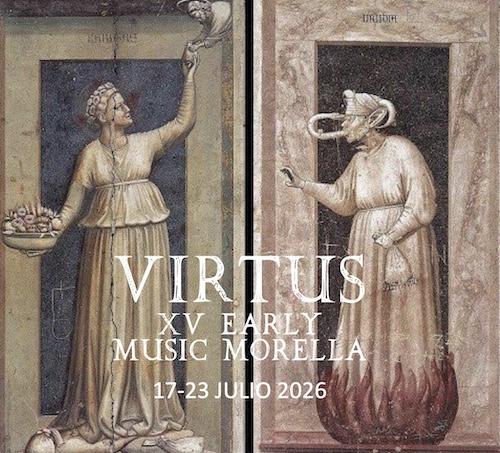15th Early Music Morella
Early Music Morella celebrates its fifteenth edition under the theme Virtus, delving into the conception of virtue as moral excellence and the disposition of the individual to act according to ideals oriented toward goodness, truth, justice, and beauty. Vice, as the antithesis of virtue, has historically been its counterpart, and the medieval allegory of the Psychomachia represents precisely the struggle between virtues and vices understood as opposing forces within the human soul. The poem Psychomachia by Prudentius, composed at the end of the fourth or the beginning of the fifth century, is the most influential work of this genre: in it, the virtues—personified as female warrior figures—combat and overcome the vices, also personified. Thus, Faith triumphs over Idolatry, Chastity over Lust, Patience over Wrath, Humility over Pride, Temperance over Indulgence, Charity over Avarice, and Concord over Discord, symbolizing the victory of good over evil and underlining the importance of moral and spiritual control.
In medieval and Renaissance art, music often appears as a symbol of harmony and virtue, while discord and vice are associated with images of chaos or profane music. Representations of the Psychomachia in manuscripts, sculpture, and painting may include figures of musicians alongside the virtues, revealing the relationship between these allegories and medieval and Renaissance music, especially in its pedagogical and formative role. Within the cultural and spiritual framework of the Middle Ages, the struggle between virtues and vices was a central theme in moral education as well as in art and in the lives of historical figures. Virtue was understood as the habitual disposition to do good and to live in accordance with Christian and moral values. The year 2026 marks the eighth centenary of the death of Saint Francis of Assisi, a model of Christian virtue whose life was characterized by humility, poverty, charity, and love of creation, and the 750th anniversary of the death of James I the Conqueror, remembered as a great king, legislator, and leader concerned with justice, peace, and governance, thereby embodying the moral ideals of his time.
In this context, medieval repertoires related to virtue will be explored, such as Gregorian chant—the principal form of medieval religious music, monophonic and vocal, used in Christian liturgy to praise God and aid the faithful in their spiritual journey, elevating the soul and promoting the virtuous life; the Ordo Virtutum of Hildegard of Bingen, one of the earliest medieval liturgical dramas, composed in the twelfth century, which narrates the struggle between the virtues and the devil for the human soul, representing the Psychomachia and serving as an educational and spiritual tool; as well as the Cantigas de Santa María of Alfonso X the Wise, which recount miracles and favors of the Virgin Mary, promoting faith, charity, and devotion as fundamental virtues. In addition, numerous conductus address the lives of saints, the importance of faith and virtue, and the struggle against sin.
During the Renaissance, music was regarded as an educational instrument capable of perfecting the human being and bringing him closer to virtue. Humanists and theorists such as Castiglione and Luther argued that music ennobled humanity and helped to express and overcome moral struggles. The Platonic conception, revived in the Renaissance, held that music had ethical value: it could draw people toward goodness and virtue, and away from vice. Thus, music continued to inspire literary and artistic works during the Renaissance as an allegory of the struggle between virtues and vices. Vocal music, especially polyphony, was used to elevate poetic and moral texts, both in church and at court, promoting values such as harmony, justice, and moral beauty, and maintaining a close connection with power and courtly life, where both musical virtuosity and moral formation were highly esteemed. Renaissance music associated with virtue encompasses the Mass and the sacred motet, as well as the moral madrigal and vihuela music. These works, both sacred and secular, promote values such as faith, justice, temperance, and pure love, reflecting the humanist ideal and the spirit of the Psychomachia in Renaissance music. Examples include the madrigals of Claudio Monteverdi—with texts that address virtue and morality—and the vihuela songs of Luis de Milán and Alonso Mudarra, based on moralizing or philosophical poetry. Also noteworthy are motets transmitting spiritual and ethical values such as devotion, humility, charity, hope, and love of neighbor, among them Ave verum corpus by Josquin des Prés, Tu es Petrus by Palestrina, O magnum mysteriumby Tomás Luis de Victoria, Justorum animae in manu Dei sunt by Orlando di Lasso, Ave verum corpus by William Byrd, and Emendemus in melius by Cristóbal de Morales.
All this is pursued while exploring the musical adventure of instrumental practice, mensuration, theory and composition techniques in the Middle Ages and Renaissance, as well as the origins of musical writing and its notational systems, and the relationship between oral and written music. The combination of elements from historical music with those of oral tradition constitutes the essence of Early Music Morella—music to understand, communicate, listen to, interpret, and enjoy through knowledge and reasoning. In this edition, alongside the Festival concerts and the instrumental and/or vocal advanced course, numerous parallel activities will be offered: guided tours, exhibitions, lectures, Med_Ren Jamsessions, workshops, with special attention to international exchange initiatives, social engagement, and the dissemination and promotion of early music for young people, the elderly, and disadvantaged groups. It will be a pleasure to share it with you all.
